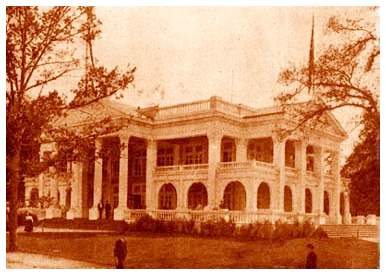Michigan's State Building was situated at the corner of Federal Avenue and Government Terrace. The building occupied 80 by 130 feet, and was of colonial renaissance architecture. It rose to the height of two stories and was surrounded by wide porches and terraces. Immediately in front and center four fluted stately columns supported the porch around the entire building. French windows were used on both floors, and their effect was emphasized and enhanced by the use of arches on the lower porch. The entire exterior was painted white and colonial cream.
The interior of the building was divided into a large reception hall, which was flanked on either side by double parlors. The decorations were of green and yellow in quiet tints. From the center of the main assembly hall an imposing staircase was raised to a landing and then to the second floor. The top floor was arranged as a large assembly room, which was decorated with scenes in green and filled with light wicker furniture. At the one side was a writing room, finished in weathered or mission furniture, and decorated with scenes of the resort sections of Michigan; on the other side were the private apartments of the commissioners.
The floors were of hard maple throughout, and were covered with attractive and beautiful rugs. The building was erected at a cost of 14,000 dollars while the furniture and fittings of native woods throughout cost approximately 5,000 dollars.
The structure's interior showcased sugar beet farming, salt production and wagon-making.
The building housed a 600-seat restaurant.
The dedication occurred May 2.
Michigan had noted displays at the Palaces of Agriculture, Varied Industries, Manufactures, Education, Mines, and Forestry.
Some of the displays included: maple-sirup and pepper.
The Palace of Horticulture included: 2,500 square feet
of tables and 100 bushels of apples grown in 1903, which had been kept in cold storage, and over 100 varieties of Michigan fruit.




